Equity and Trusts: Analyzing the Paradox of Flexibility and Rigidity
VerifiedAdded on 2023/04/21
|13
|3093
|209
Essay
AI Summary
This essay explores the inherent paradox within the doctrine of equity, specifically within the context of trust law, highlighting its seemingly contradictory nature of being both wilfully flexible and rigidly dogmatic. It examines key aspects such as the certainties required for a valid trust (intention, subject matter, and object), the operation of equity in creating constructive trusts, and the rights and obligations of trustees and beneficiaries. The discussion includes relevant case law, such as Knight v Knight and Mcphail v Dalton, to illustrate the application of these principles. Furthermore, the essay analyzes how equity and trust law function in social and commercial contexts, emphasizing equity's role in achieving fairness and preventing unjust enrichment where common law remedies fall short, as demonstrated in cases like Pettus v Becker. The analysis shows the courts' discretionary power to adapt legal rulings to meet societal needs and achieve justice. Desklib offers a repository of solved assignments for students.

Equity
1
1
Paraphrase This Document
Need a fresh take? Get an instant paraphrase of this document with our AI Paraphraser
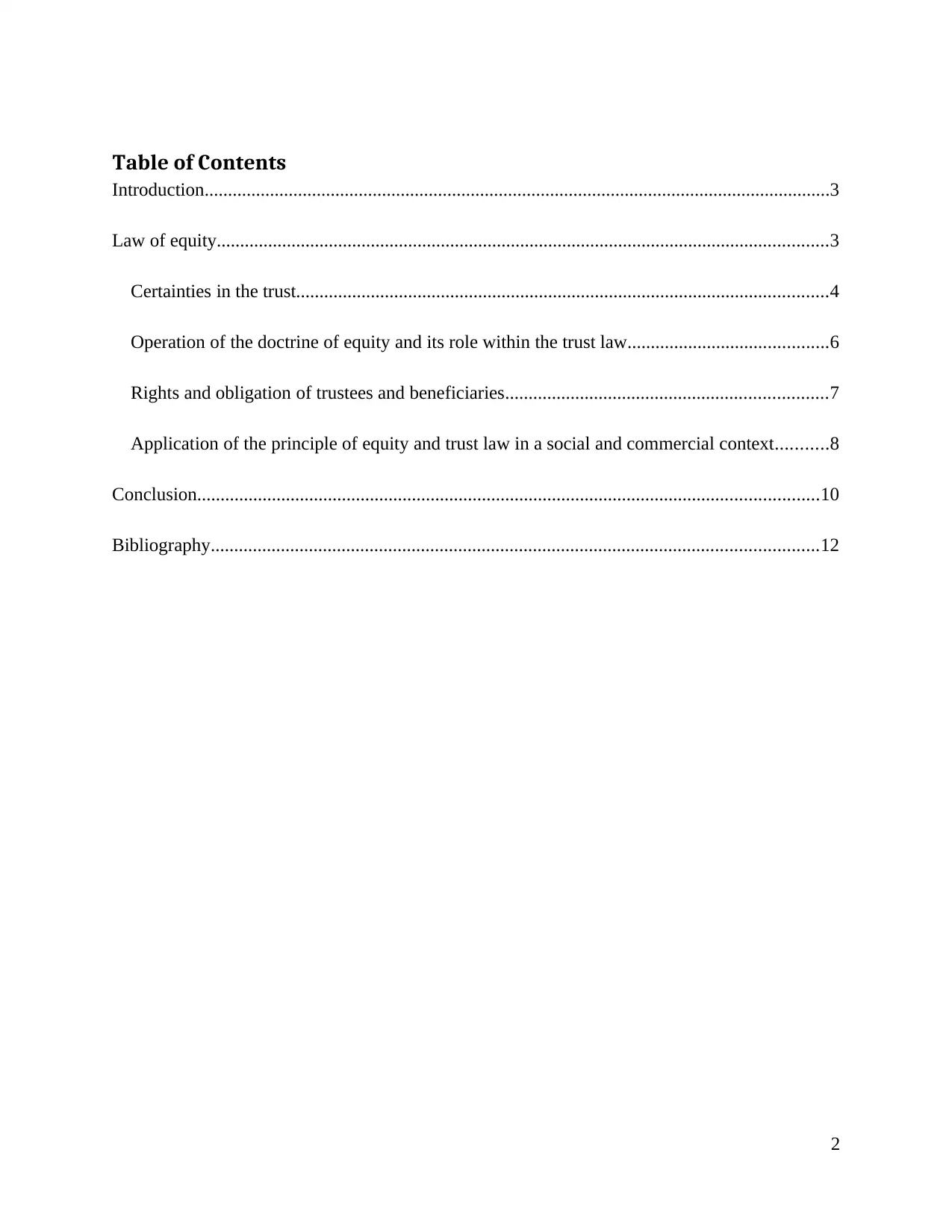
Table of Contents
Introduction......................................................................................................................................3
Law of equity...................................................................................................................................3
Certainties in the trust..................................................................................................................4
Operation of the doctrine of equity and its role within the trust law...........................................6
Rights and obligation of trustees and beneficiaries.....................................................................7
Application of the principle of equity and trust law in a social and commercial context...........8
Conclusion.....................................................................................................................................10
Bibliography..................................................................................................................................12
2
Introduction......................................................................................................................................3
Law of equity...................................................................................................................................3
Certainties in the trust..................................................................................................................4
Operation of the doctrine of equity and its role within the trust law...........................................6
Rights and obligation of trustees and beneficiaries.....................................................................7
Application of the principle of equity and trust law in a social and commercial context...........8
Conclusion.....................................................................................................................................10
Bibliography..................................................................................................................................12
2
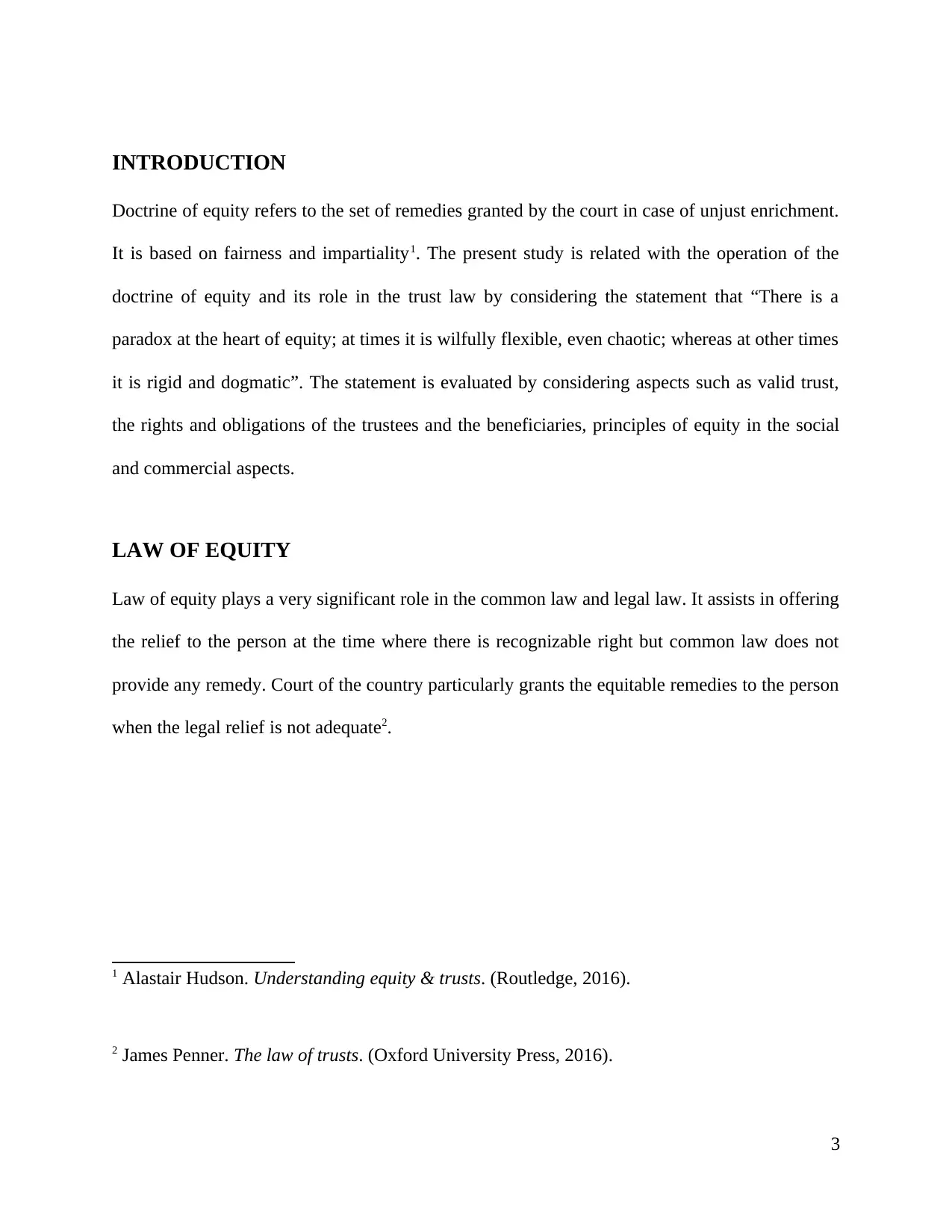
INTRODUCTION
Doctrine of equity refers to the set of remedies granted by the court in case of unjust enrichment.
It is based on fairness and impartiality1. The present study is related with the operation of the
doctrine of equity and its role in the trust law by considering the statement that “There is a
paradox at the heart of equity; at times it is wilfully flexible, even chaotic; whereas at other times
it is rigid and dogmatic”. The statement is evaluated by considering aspects such as valid trust,
the rights and obligations of the trustees and the beneficiaries, principles of equity in the social
and commercial aspects.
LAW OF EQUITY
Law of equity plays a very significant role in the common law and legal law. It assists in offering
the relief to the person at the time where there is recognizable right but common law does not
provide any remedy. Court of the country particularly grants the equitable remedies to the person
when the legal relief is not adequate2.
1 Alastair Hudson. Understanding equity & trusts. (Routledge, 2016).
2 James Penner. The law of trusts. (Oxford University Press, 2016).
3
Doctrine of equity refers to the set of remedies granted by the court in case of unjust enrichment.
It is based on fairness and impartiality1. The present study is related with the operation of the
doctrine of equity and its role in the trust law by considering the statement that “There is a
paradox at the heart of equity; at times it is wilfully flexible, even chaotic; whereas at other times
it is rigid and dogmatic”. The statement is evaluated by considering aspects such as valid trust,
the rights and obligations of the trustees and the beneficiaries, principles of equity in the social
and commercial aspects.
LAW OF EQUITY
Law of equity plays a very significant role in the common law and legal law. It assists in offering
the relief to the person at the time where there is recognizable right but common law does not
provide any remedy. Court of the country particularly grants the equitable remedies to the person
when the legal relief is not adequate2.
1 Alastair Hudson. Understanding equity & trusts. (Routledge, 2016).
2 James Penner. The law of trusts. (Oxford University Press, 2016).
3
⊘ This is a preview!⊘
Do you want full access?
Subscribe today to unlock all pages.

Trusted by 1+ million students worldwide
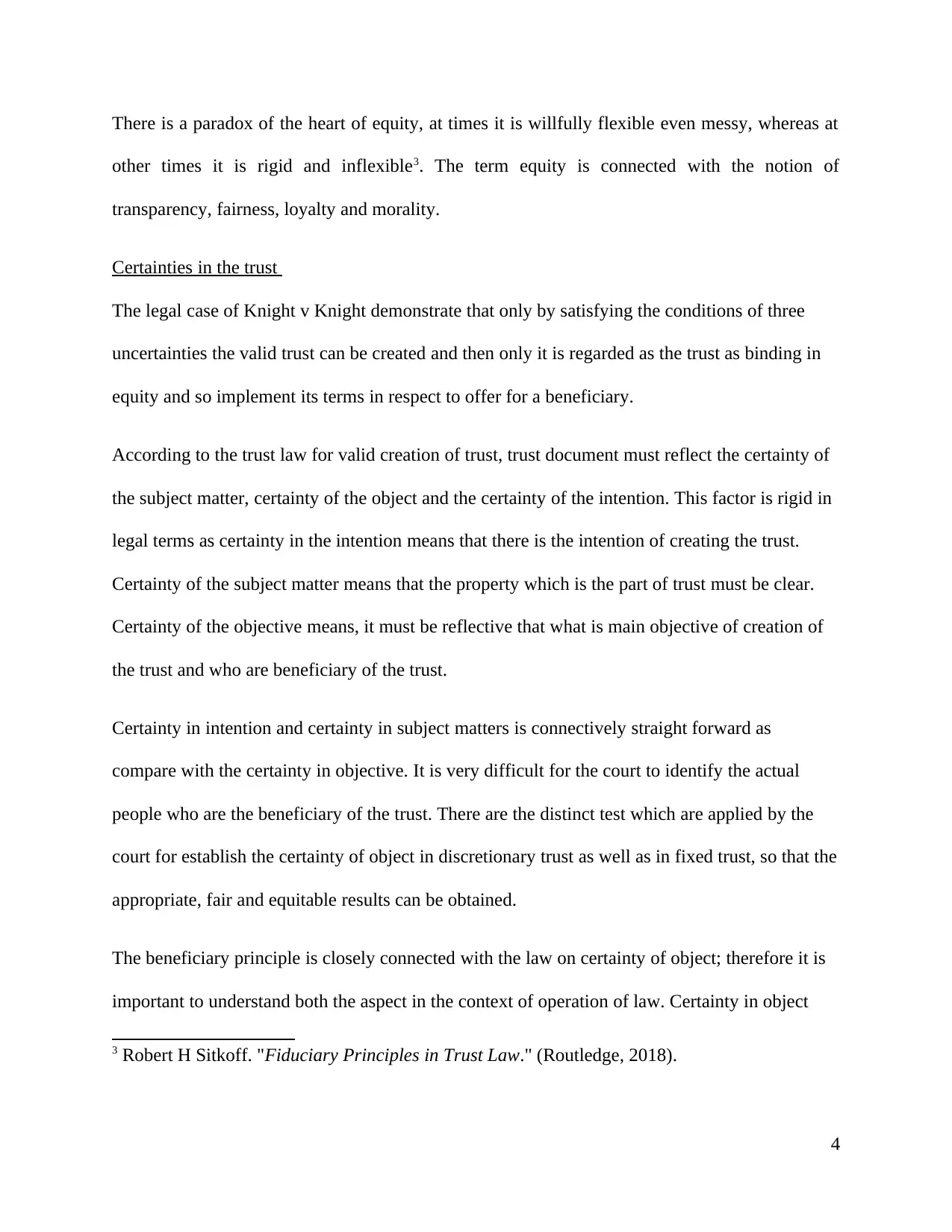
There is a paradox of the heart of equity, at times it is willfully flexible even messy, whereas at
other times it is rigid and inflexible3. The term equity is connected with the notion of
transparency, fairness, loyalty and morality.
Certainties in the trust
The legal case of Knight v Knight demonstrate that only by satisfying the conditions of three
uncertainties the valid trust can be created and then only it is regarded as the trust as binding in
equity and so implement its terms in respect to offer for a beneficiary.
According to the trust law for valid creation of trust, trust document must reflect the certainty of
the subject matter, certainty of the object and the certainty of the intention. This factor is rigid in
legal terms as certainty in the intention means that there is the intention of creating the trust.
Certainty of the subject matter means that the property which is the part of trust must be clear.
Certainty of the objective means, it must be reflective that what is main objective of creation of
the trust and who are beneficiary of the trust.
Certainty in intention and certainty in subject matters is connectively straight forward as
compare with the certainty in objective. It is very difficult for the court to identify the actual
people who are the beneficiary of the trust. There are the distinct test which are applied by the
court for establish the certainty of object in discretionary trust as well as in fixed trust, so that the
appropriate, fair and equitable results can be obtained.
The beneficiary principle is closely connected with the law on certainty of object; therefore it is
important to understand both the aspect in the context of operation of law. Certainty in object
3 Robert H Sitkoff. "Fiduciary Principles in Trust Law." (Routledge, 2018).
4
other times it is rigid and inflexible3. The term equity is connected with the notion of
transparency, fairness, loyalty and morality.
Certainties in the trust
The legal case of Knight v Knight demonstrate that only by satisfying the conditions of three
uncertainties the valid trust can be created and then only it is regarded as the trust as binding in
equity and so implement its terms in respect to offer for a beneficiary.
According to the trust law for valid creation of trust, trust document must reflect the certainty of
the subject matter, certainty of the object and the certainty of the intention. This factor is rigid in
legal terms as certainty in the intention means that there is the intention of creating the trust.
Certainty of the subject matter means that the property which is the part of trust must be clear.
Certainty of the objective means, it must be reflective that what is main objective of creation of
the trust and who are beneficiary of the trust.
Certainty in intention and certainty in subject matters is connectively straight forward as
compare with the certainty in objective. It is very difficult for the court to identify the actual
people who are the beneficiary of the trust. There are the distinct test which are applied by the
court for establish the certainty of object in discretionary trust as well as in fixed trust, so that the
appropriate, fair and equitable results can be obtained.
The beneficiary principle is closely connected with the law on certainty of object; therefore it is
important to understand both the aspect in the context of operation of law. Certainty in object
3 Robert H Sitkoff. "Fiduciary Principles in Trust Law." (Routledge, 2018).
4
Paraphrase This Document
Need a fresh take? Get an instant paraphrase of this document with our AI Paraphraser
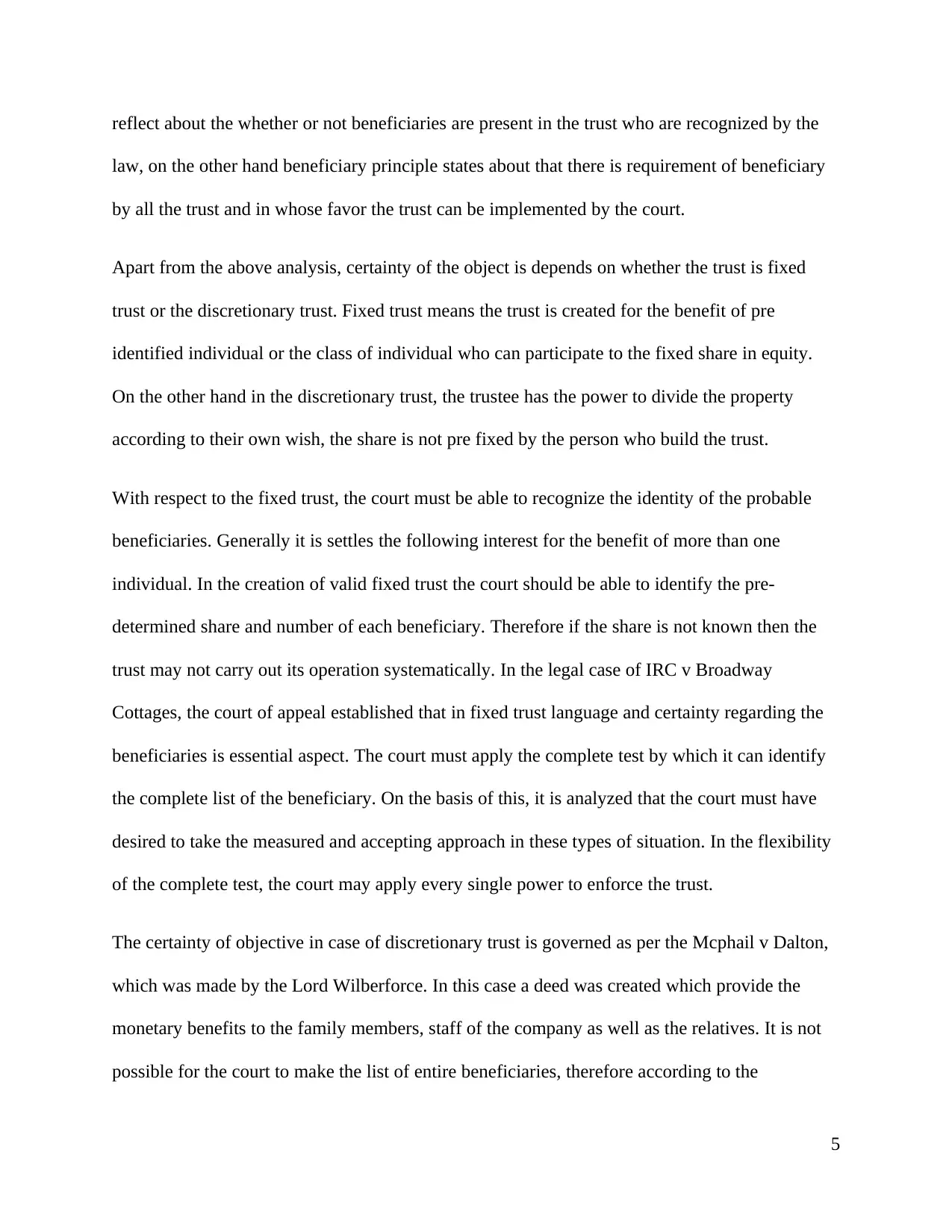
reflect about the whether or not beneficiaries are present in the trust who are recognized by the
law, on the other hand beneficiary principle states about that there is requirement of beneficiary
by all the trust and in whose favor the trust can be implemented by the court.
Apart from the above analysis, certainty of the object is depends on whether the trust is fixed
trust or the discretionary trust. Fixed trust means the trust is created for the benefit of pre
identified individual or the class of individual who can participate to the fixed share in equity.
On the other hand in the discretionary trust, the trustee has the power to divide the property
according to their own wish, the share is not pre fixed by the person who build the trust.
With respect to the fixed trust, the court must be able to recognize the identity of the probable
beneficiaries. Generally it is settles the following interest for the benefit of more than one
individual. In the creation of valid fixed trust the court should be able to identify the pre-
determined share and number of each beneficiary. Therefore if the share is not known then the
trust may not carry out its operation systematically. In the legal case of IRC v Broadway
Cottages, the court of appeal established that in fixed trust language and certainty regarding the
beneficiaries is essential aspect. The court must apply the complete test by which it can identify
the complete list of the beneficiary. On the basis of this, it is analyzed that the court must have
desired to take the measured and accepting approach in these types of situation. In the flexibility
of the complete test, the court may apply every single power to enforce the trust.
The certainty of objective in case of discretionary trust is governed as per the Mcphail v Dalton,
which was made by the Lord Wilberforce. In this case a deed was created which provide the
monetary benefits to the family members, staff of the company as well as the relatives. It is not
possible for the court to make the list of entire beneficiaries, therefore according to the
5
law, on the other hand beneficiary principle states about that there is requirement of beneficiary
by all the trust and in whose favor the trust can be implemented by the court.
Apart from the above analysis, certainty of the object is depends on whether the trust is fixed
trust or the discretionary trust. Fixed trust means the trust is created for the benefit of pre
identified individual or the class of individual who can participate to the fixed share in equity.
On the other hand in the discretionary trust, the trustee has the power to divide the property
according to their own wish, the share is not pre fixed by the person who build the trust.
With respect to the fixed trust, the court must be able to recognize the identity of the probable
beneficiaries. Generally it is settles the following interest for the benefit of more than one
individual. In the creation of valid fixed trust the court should be able to identify the pre-
determined share and number of each beneficiary. Therefore if the share is not known then the
trust may not carry out its operation systematically. In the legal case of IRC v Broadway
Cottages, the court of appeal established that in fixed trust language and certainty regarding the
beneficiaries is essential aspect. The court must apply the complete test by which it can identify
the complete list of the beneficiary. On the basis of this, it is analyzed that the court must have
desired to take the measured and accepting approach in these types of situation. In the flexibility
of the complete test, the court may apply every single power to enforce the trust.
The certainty of objective in case of discretionary trust is governed as per the Mcphail v Dalton,
which was made by the Lord Wilberforce. In this case a deed was created which provide the
monetary benefits to the family members, staff of the company as well as the relatives. It is not
possible for the court to make the list of entire beneficiaries, therefore according to the
5

conventional test, the trust was invalid. However Lord Wilberforce ruled that the court can
identify that individual was a member and therefore the issue was addressed by applying the
conceptual sense and it was held that it will not against the interest of the trust even if the
physical location and the existence of the beneficiary is not known to the court or the trustee. The
essential aspect is related with the conceptual certainty regarding the class of beneficiary. By
applying the ruling given under the case Mcphail v Dalton, the court applies the flexibility
approach but there is still the possibility perverting arrangement that are not conceptually certain.
Operation of the doctrine of equity and its role within the trust law
Trust law related with the creation and safeguarding the asset funds, which are usually possess
by the one party for the benefit of another party. Trusts are created by the person who settles the
property on the basis of the trust law for the benefit of the beneficiaries4. For the protection of the
settlor and the beneficiaries certain requirement specified in the act such as the intention of
creating the trust, asset which are held in the trust and the people who are regarded as the
beneficiaries are defined. Away from the expressly created trust, there are constructive trust and
resulting trust which is created by the operation of the law. Constructive trust is the outcome of
the doctrine of equity5. For preventing the unjust enrichment the court may provide the equitable
remedy in which it makes the order to hold the property of person on behalf of some other
person.
4 Graham Virgo. The Principles of Equity & Trusts. (Oxford university press, 2018).
5 Robert French. "Trusts and statutes." (Melb. UL Rev. 39 2015) Pp 629.
6
identify that individual was a member and therefore the issue was addressed by applying the
conceptual sense and it was held that it will not against the interest of the trust even if the
physical location and the existence of the beneficiary is not known to the court or the trustee. The
essential aspect is related with the conceptual certainty regarding the class of beneficiary. By
applying the ruling given under the case Mcphail v Dalton, the court applies the flexibility
approach but there is still the possibility perverting arrangement that are not conceptually certain.
Operation of the doctrine of equity and its role within the trust law
Trust law related with the creation and safeguarding the asset funds, which are usually possess
by the one party for the benefit of another party. Trusts are created by the person who settles the
property on the basis of the trust law for the benefit of the beneficiaries4. For the protection of the
settlor and the beneficiaries certain requirement specified in the act such as the intention of
creating the trust, asset which are held in the trust and the people who are regarded as the
beneficiaries are defined. Away from the expressly created trust, there are constructive trust and
resulting trust which is created by the operation of the law. Constructive trust is the outcome of
the doctrine of equity5. For preventing the unjust enrichment the court may provide the equitable
remedy in which it makes the order to hold the property of person on behalf of some other
person.
4 Graham Virgo. The Principles of Equity & Trusts. (Oxford university press, 2018).
5 Robert French. "Trusts and statutes." (Melb. UL Rev. 39 2015) Pp 629.
6
⊘ This is a preview!⊘
Do you want full access?
Subscribe today to unlock all pages.

Trusted by 1+ million students worldwide
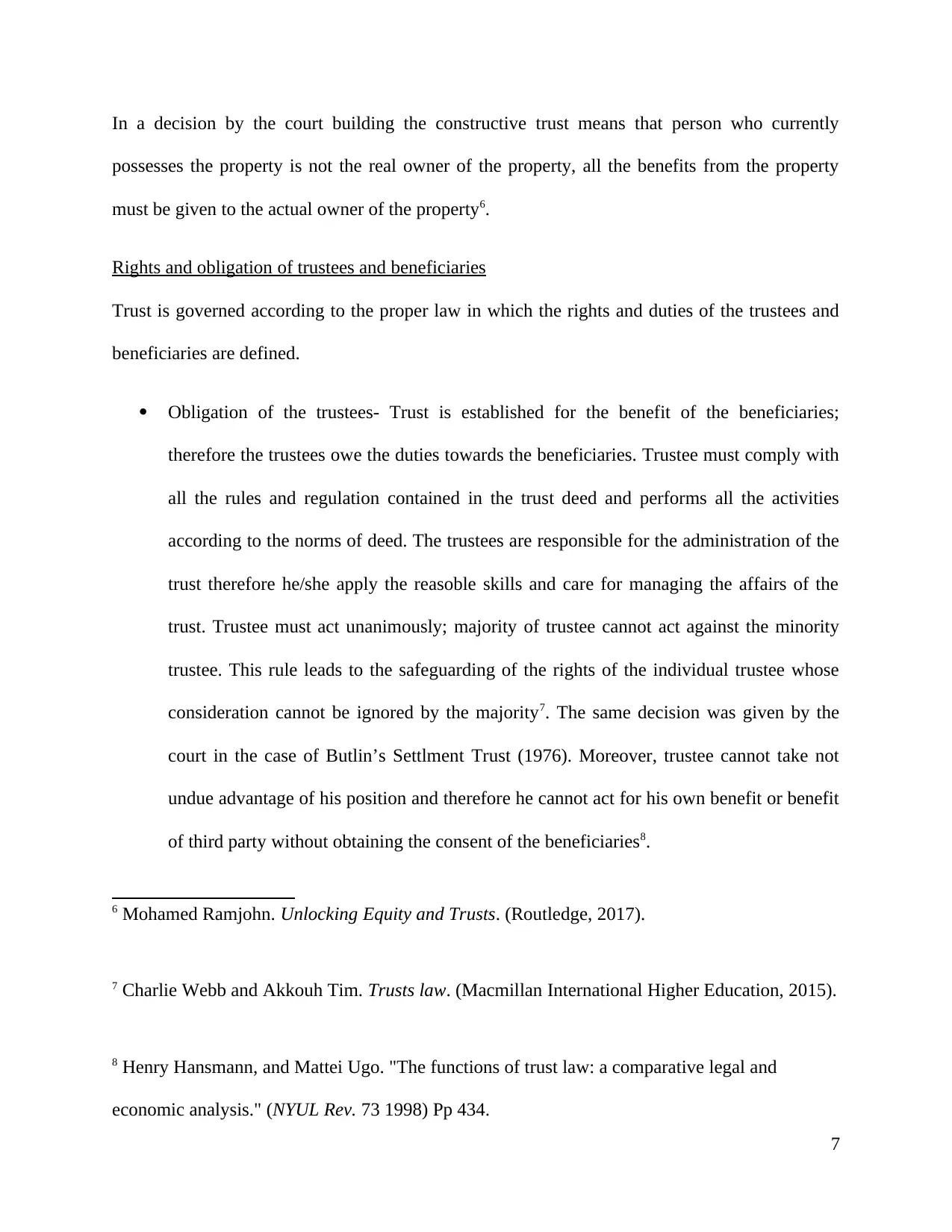
In a decision by the court building the constructive trust means that person who currently
possesses the property is not the real owner of the property, all the benefits from the property
must be given to the actual owner of the property6.
Rights and obligation of trustees and beneficiaries
Trust is governed according to the proper law in which the rights and duties of the trustees and
beneficiaries are defined.
Obligation of the trustees- Trust is established for the benefit of the beneficiaries;
therefore the trustees owe the duties towards the beneficiaries. Trustee must comply with
all the rules and regulation contained in the trust deed and performs all the activities
according to the norms of deed. The trustees are responsible for the administration of the
trust therefore he/she apply the reasoble skills and care for managing the affairs of the
trust. Trustee must act unanimously; majority of trustee cannot act against the minority
trustee. This rule leads to the safeguarding of the rights of the individual trustee whose
consideration cannot be ignored by the majority7. The same decision was given by the
court in the case of Butlin’s Settlment Trust (1976). Moreover, trustee cannot take not
undue advantage of his position and therefore he cannot act for his own benefit or benefit
of third party without obtaining the consent of the beneficiaries8.
6 Mohamed Ramjohn. Unlocking Equity and Trusts. (Routledge, 2017).
7 Charlie Webb and Akkouh Tim. Trusts law. (Macmillan International Higher Education, 2015).
8 Henry Hansmann, and Mattei Ugo. "The functions of trust law: a comparative legal and
economic analysis." (NYUL Rev. 73 1998) Pp 434.
7
possesses the property is not the real owner of the property, all the benefits from the property
must be given to the actual owner of the property6.
Rights and obligation of trustees and beneficiaries
Trust is governed according to the proper law in which the rights and duties of the trustees and
beneficiaries are defined.
Obligation of the trustees- Trust is established for the benefit of the beneficiaries;
therefore the trustees owe the duties towards the beneficiaries. Trustee must comply with
all the rules and regulation contained in the trust deed and performs all the activities
according to the norms of deed. The trustees are responsible for the administration of the
trust therefore he/she apply the reasoble skills and care for managing the affairs of the
trust. Trustee must act unanimously; majority of trustee cannot act against the minority
trustee. This rule leads to the safeguarding of the rights of the individual trustee whose
consideration cannot be ignored by the majority7. The same decision was given by the
court in the case of Butlin’s Settlment Trust (1976). Moreover, trustee cannot take not
undue advantage of his position and therefore he cannot act for his own benefit or benefit
of third party without obtaining the consent of the beneficiaries8.
6 Mohamed Ramjohn. Unlocking Equity and Trusts. (Routledge, 2017).
7 Charlie Webb and Akkouh Tim. Trusts law. (Macmillan International Higher Education, 2015).
8 Henry Hansmann, and Mattei Ugo. "The functions of trust law: a comparative legal and
economic analysis." (NYUL Rev. 73 1998) Pp 434.
7
Paraphrase This Document
Need a fresh take? Get an instant paraphrase of this document with our AI Paraphraser
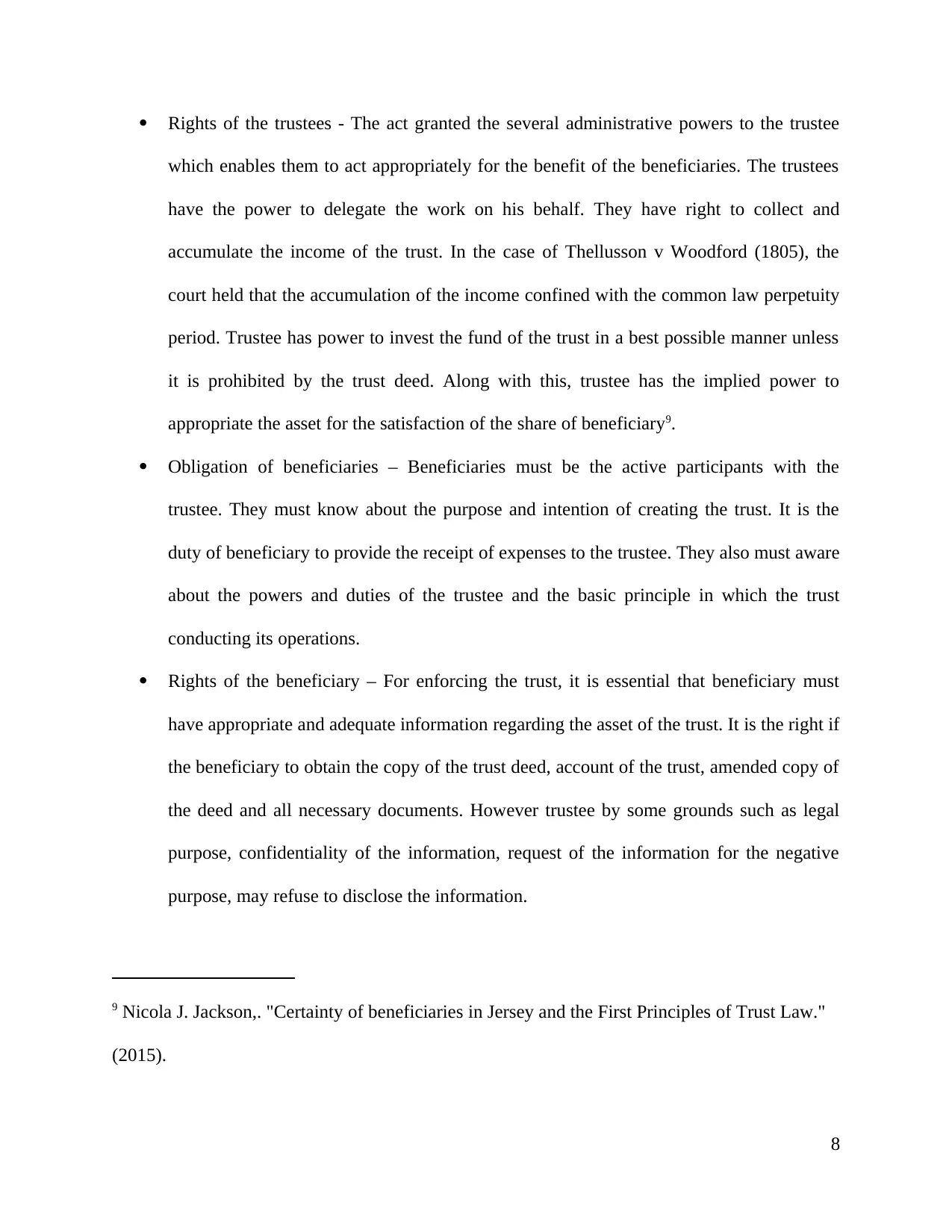
Rights of the trustees - The act granted the several administrative powers to the trustee
which enables them to act appropriately for the benefit of the beneficiaries. The trustees
have the power to delegate the work on his behalf. They have right to collect and
accumulate the income of the trust. In the case of Thellusson v Woodford (1805), the
court held that the accumulation of the income confined with the common law perpetuity
period. Trustee has power to invest the fund of the trust in a best possible manner unless
it is prohibited by the trust deed. Along with this, trustee has the implied power to
appropriate the asset for the satisfaction of the share of beneficiary9.
Obligation of beneficiaries – Beneficiaries must be the active participants with the
trustee. They must know about the purpose and intention of creating the trust. It is the
duty of beneficiary to provide the receipt of expenses to the trustee. They also must aware
about the powers and duties of the trustee and the basic principle in which the trust
conducting its operations.
Rights of the beneficiary – For enforcing the trust, it is essential that beneficiary must
have appropriate and adequate information regarding the asset of the trust. It is the right if
the beneficiary to obtain the copy of the trust deed, account of the trust, amended copy of
the deed and all necessary documents. However trustee by some grounds such as legal
purpose, confidentiality of the information, request of the information for the negative
purpose, may refuse to disclose the information.
9 Nicola J. Jackson,. "Certainty of beneficiaries in Jersey and the First Principles of Trust Law."
(2015).
8
which enables them to act appropriately for the benefit of the beneficiaries. The trustees
have the power to delegate the work on his behalf. They have right to collect and
accumulate the income of the trust. In the case of Thellusson v Woodford (1805), the
court held that the accumulation of the income confined with the common law perpetuity
period. Trustee has power to invest the fund of the trust in a best possible manner unless
it is prohibited by the trust deed. Along with this, trustee has the implied power to
appropriate the asset for the satisfaction of the share of beneficiary9.
Obligation of beneficiaries – Beneficiaries must be the active participants with the
trustee. They must know about the purpose and intention of creating the trust. It is the
duty of beneficiary to provide the receipt of expenses to the trustee. They also must aware
about the powers and duties of the trustee and the basic principle in which the trust
conducting its operations.
Rights of the beneficiary – For enforcing the trust, it is essential that beneficiary must
have appropriate and adequate information regarding the asset of the trust. It is the right if
the beneficiary to obtain the copy of the trust deed, account of the trust, amended copy of
the deed and all necessary documents. However trustee by some grounds such as legal
purpose, confidentiality of the information, request of the information for the negative
purpose, may refuse to disclose the information.
9 Nicola J. Jackson,. "Certainty of beneficiaries in Jersey and the First Principles of Trust Law."
(2015).
8
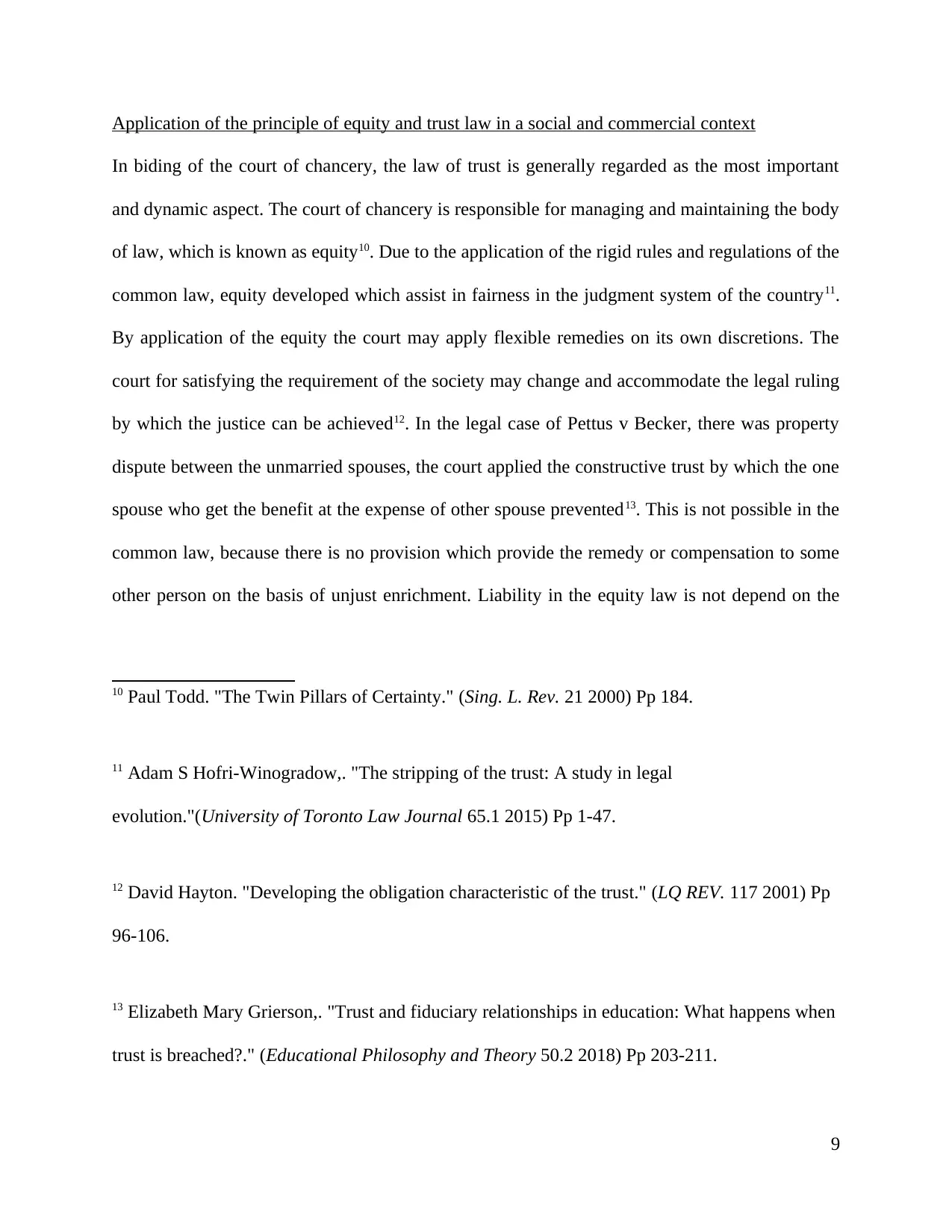
Application of the principle of equity and trust law in a social and commercial context
In biding of the court of chancery, the law of trust is generally regarded as the most important
and dynamic aspect. The court of chancery is responsible for managing and maintaining the body
of law, which is known as equity10. Due to the application of the rigid rules and regulations of the
common law, equity developed which assist in fairness in the judgment system of the country11.
By application of the equity the court may apply flexible remedies on its own discretions. The
court for satisfying the requirement of the society may change and accommodate the legal ruling
by which the justice can be achieved12. In the legal case of Pettus v Becker, there was property
dispute between the unmarried spouses, the court applied the constructive trust by which the one
spouse who get the benefit at the expense of other spouse prevented13. This is not possible in the
common law, because there is no provision which provide the remedy or compensation to some
other person on the basis of unjust enrichment. Liability in the equity law is not depend on the
10 Paul Todd. "The Twin Pillars of Certainty." (Sing. L. Rev. 21 2000) Pp 184.
11 Adam S Hofri-Winogradow,. "The stripping of the trust: A study in legal
evolution."(University of Toronto Law Journal 65.1 2015) Pp 1-47.
12 David Hayton. "Developing the obligation characteristic of the trust." (LQ REV. 117 2001) Pp
96-106.
13 Elizabeth Mary Grierson,. "Trust and fiduciary relationships in education: What happens when
trust is breached?." (Educational Philosophy and Theory 50.2 2018) Pp 203-211.
9
In biding of the court of chancery, the law of trust is generally regarded as the most important
and dynamic aspect. The court of chancery is responsible for managing and maintaining the body
of law, which is known as equity10. Due to the application of the rigid rules and regulations of the
common law, equity developed which assist in fairness in the judgment system of the country11.
By application of the equity the court may apply flexible remedies on its own discretions. The
court for satisfying the requirement of the society may change and accommodate the legal ruling
by which the justice can be achieved12. In the legal case of Pettus v Becker, there was property
dispute between the unmarried spouses, the court applied the constructive trust by which the one
spouse who get the benefit at the expense of other spouse prevented13. This is not possible in the
common law, because there is no provision which provide the remedy or compensation to some
other person on the basis of unjust enrichment. Liability in the equity law is not depend on the
10 Paul Todd. "The Twin Pillars of Certainty." (Sing. L. Rev. 21 2000) Pp 184.
11 Adam S Hofri-Winogradow,. "The stripping of the trust: A study in legal
evolution."(University of Toronto Law Journal 65.1 2015) Pp 1-47.
12 David Hayton. "Developing the obligation characteristic of the trust." (LQ REV. 117 2001) Pp
96-106.
13 Elizabeth Mary Grierson,. "Trust and fiduciary relationships in education: What happens when
trust is breached?." (Educational Philosophy and Theory 50.2 2018) Pp 203-211.
9
⊘ This is a preview!⊘
Do you want full access?
Subscribe today to unlock all pages.

Trusted by 1+ million students worldwide
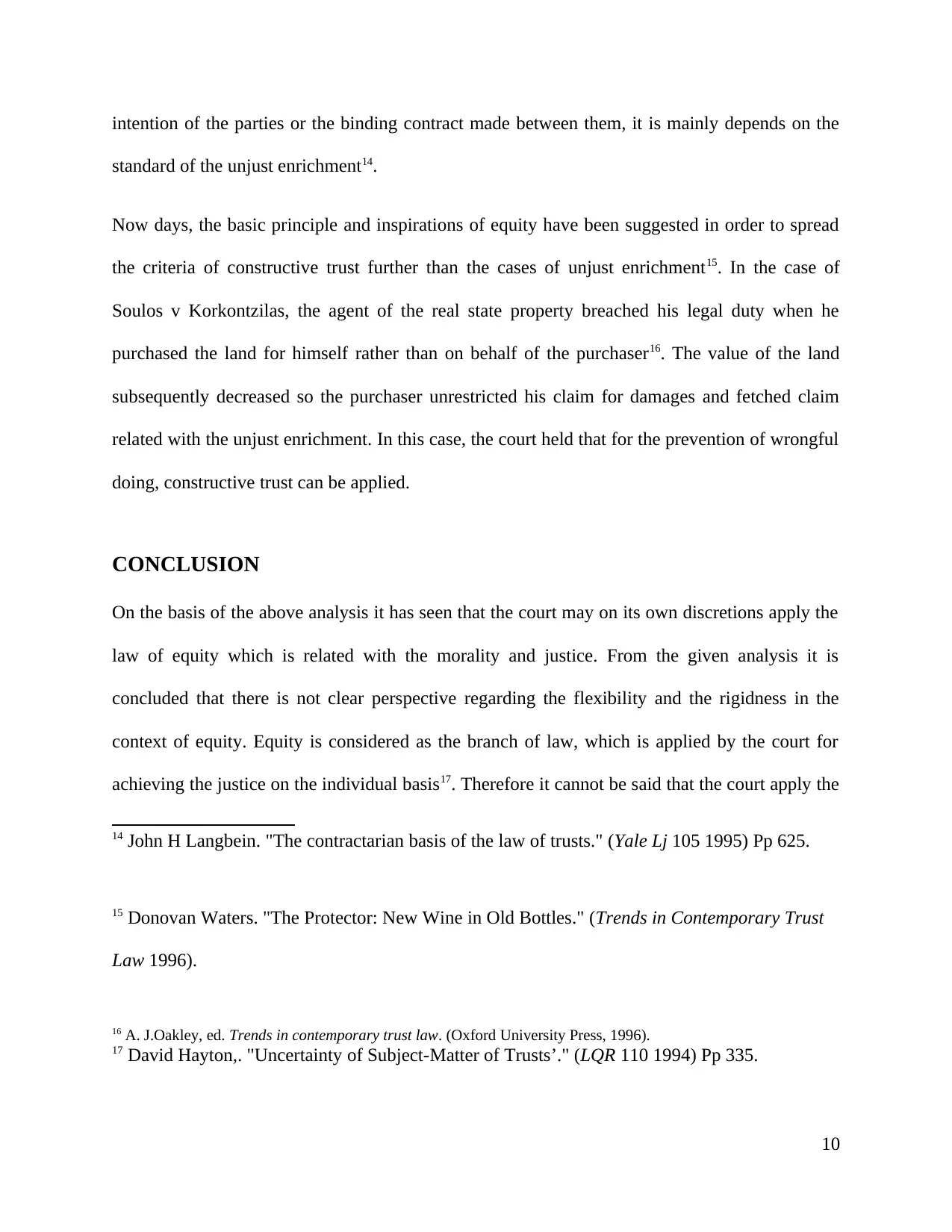
intention of the parties or the binding contract made between them, it is mainly depends on the
standard of the unjust enrichment14.
Now days, the basic principle and inspirations of equity have been suggested in order to spread
the criteria of constructive trust further than the cases of unjust enrichment15. In the case of
Soulos v Korkontzilas, the agent of the real state property breached his legal duty when he
purchased the land for himself rather than on behalf of the purchaser16. The value of the land
subsequently decreased so the purchaser unrestricted his claim for damages and fetched claim
related with the unjust enrichment. In this case, the court held that for the prevention of wrongful
doing, constructive trust can be applied.
CONCLUSION
On the basis of the above analysis it has seen that the court may on its own discretions apply the
law of equity which is related with the morality and justice. From the given analysis it is
concluded that there is not clear perspective regarding the flexibility and the rigidness in the
context of equity. Equity is considered as the branch of law, which is applied by the court for
achieving the justice on the individual basis17. Therefore it cannot be said that the court apply the
14 John H Langbein. "The contractarian basis of the law of trusts." (Yale Lj 105 1995) Pp 625.
15 Donovan Waters. "The Protector: New Wine in Old Bottles." (Trends in Contemporary Trust
Law 1996).
16 A. J.Oakley, ed. Trends in contemporary trust law. (Oxford University Press, 1996).
17 David Hayton,. "Uncertainty of Subject-Matter of Trusts’." (LQR 110 1994) Pp 335.
10
standard of the unjust enrichment14.
Now days, the basic principle and inspirations of equity have been suggested in order to spread
the criteria of constructive trust further than the cases of unjust enrichment15. In the case of
Soulos v Korkontzilas, the agent of the real state property breached his legal duty when he
purchased the land for himself rather than on behalf of the purchaser16. The value of the land
subsequently decreased so the purchaser unrestricted his claim for damages and fetched claim
related with the unjust enrichment. In this case, the court held that for the prevention of wrongful
doing, constructive trust can be applied.
CONCLUSION
On the basis of the above analysis it has seen that the court may on its own discretions apply the
law of equity which is related with the morality and justice. From the given analysis it is
concluded that there is not clear perspective regarding the flexibility and the rigidness in the
context of equity. Equity is considered as the branch of law, which is applied by the court for
achieving the justice on the individual basis17. Therefore it cannot be said that the court apply the
14 John H Langbein. "The contractarian basis of the law of trusts." (Yale Lj 105 1995) Pp 625.
15 Donovan Waters. "The Protector: New Wine in Old Bottles." (Trends in Contemporary Trust
Law 1996).
16 A. J.Oakley, ed. Trends in contemporary trust law. (Oxford University Press, 1996).
17 David Hayton,. "Uncertainty of Subject-Matter of Trusts’." (LQR 110 1994) Pp 335.
10
Paraphrase This Document
Need a fresh take? Get an instant paraphrase of this document with our AI Paraphraser
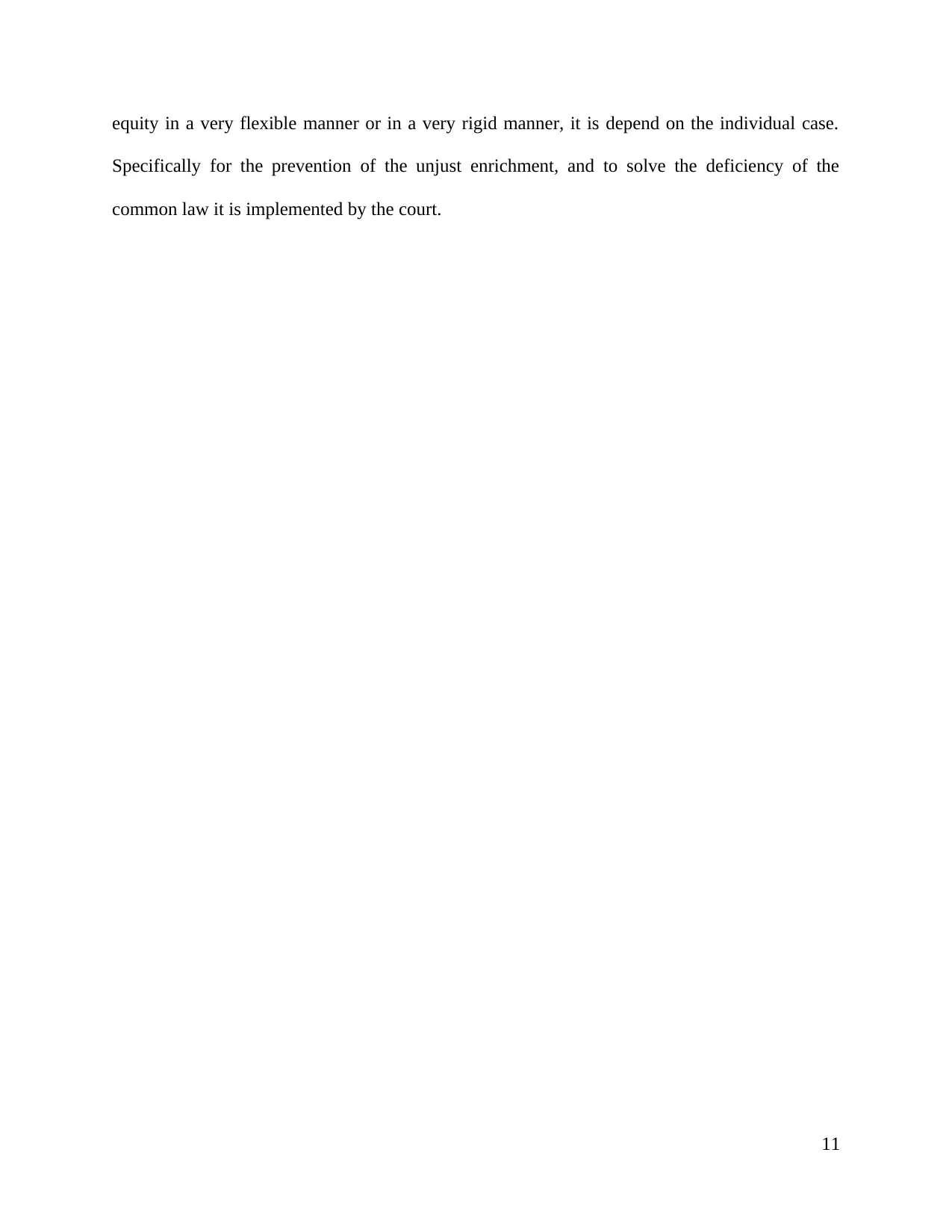
equity in a very flexible manner or in a very rigid manner, it is depend on the individual case.
Specifically for the prevention of the unjust enrichment, and to solve the deficiency of the
common law it is implemented by the court.
11
Specifically for the prevention of the unjust enrichment, and to solve the deficiency of the
common law it is implemented by the court.
11
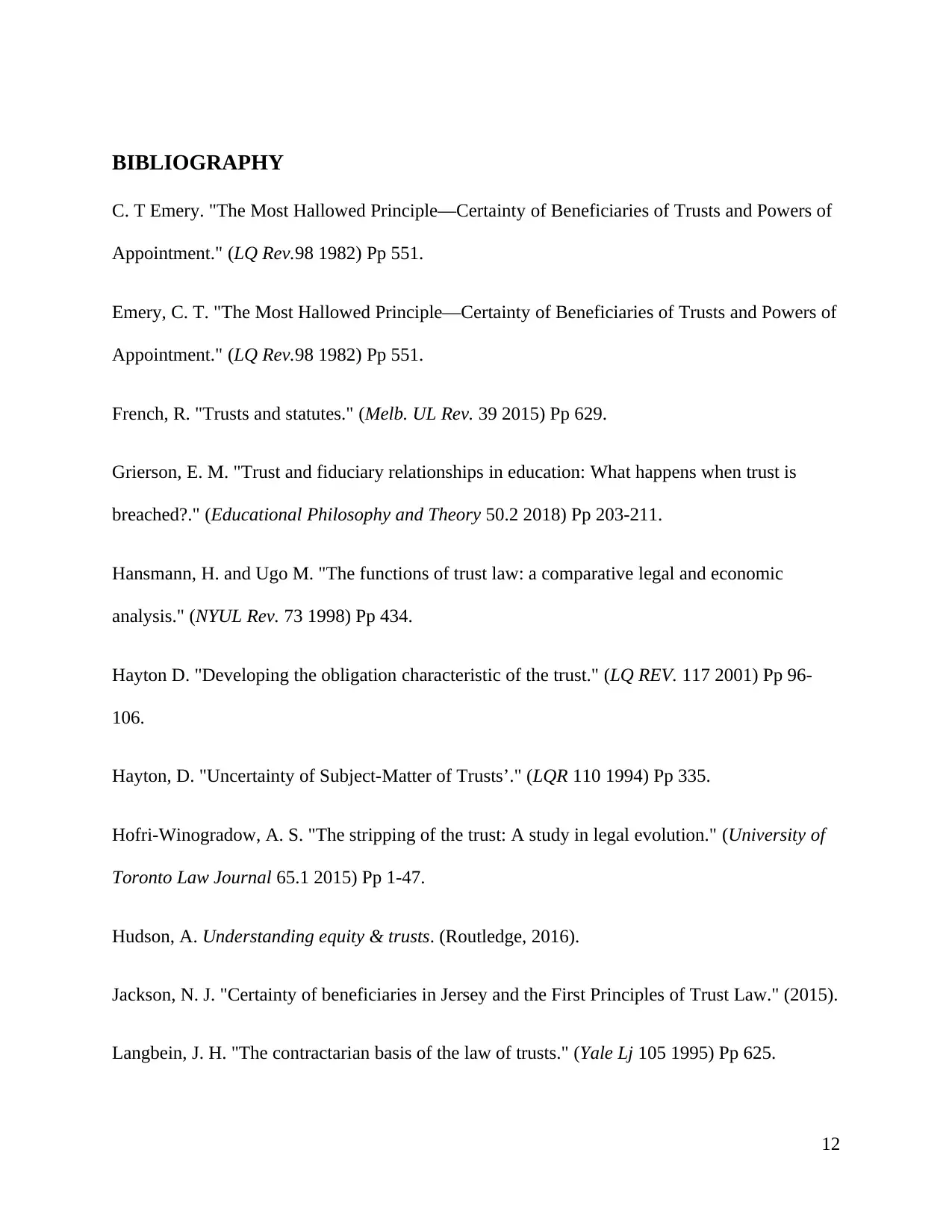
BIBLIOGRAPHY
C. T Emery. "The Most Hallowed Principle—Certainty of Beneficiaries of Trusts and Powers of
Appointment." (LQ Rev.98 1982) Pp 551.
Emery, C. T. "The Most Hallowed Principle—Certainty of Beneficiaries of Trusts and Powers of
Appointment." (LQ Rev.98 1982) Pp 551.
French, R. "Trusts and statutes." (Melb. UL Rev. 39 2015) Pp 629.
Grierson, E. M. "Trust and fiduciary relationships in education: What happens when trust is
breached?." (Educational Philosophy and Theory 50.2 2018) Pp 203-211.
Hansmann, H. and Ugo M. "The functions of trust law: a comparative legal and economic
analysis." (NYUL Rev. 73 1998) Pp 434.
Hayton D. "Developing the obligation characteristic of the trust." (LQ REV. 117 2001) Pp 96-
106.
Hayton, D. "Uncertainty of Subject-Matter of Trusts’." (LQR 110 1994) Pp 335.
Hofri-Winogradow, A. S. "The stripping of the trust: A study in legal evolution." (University of
Toronto Law Journal 65.1 2015) Pp 1-47.
Hudson, A. Understanding equity & trusts. (Routledge, 2016).
Jackson, N. J. "Certainty of beneficiaries in Jersey and the First Principles of Trust Law." (2015).
Langbein, J. H. "The contractarian basis of the law of trusts." (Yale Lj 105 1995) Pp 625.
12
C. T Emery. "The Most Hallowed Principle—Certainty of Beneficiaries of Trusts and Powers of
Appointment." (LQ Rev.98 1982) Pp 551.
Emery, C. T. "The Most Hallowed Principle—Certainty of Beneficiaries of Trusts and Powers of
Appointment." (LQ Rev.98 1982) Pp 551.
French, R. "Trusts and statutes." (Melb. UL Rev. 39 2015) Pp 629.
Grierson, E. M. "Trust and fiduciary relationships in education: What happens when trust is
breached?." (Educational Philosophy and Theory 50.2 2018) Pp 203-211.
Hansmann, H. and Ugo M. "The functions of trust law: a comparative legal and economic
analysis." (NYUL Rev. 73 1998) Pp 434.
Hayton D. "Developing the obligation characteristic of the trust." (LQ REV. 117 2001) Pp 96-
106.
Hayton, D. "Uncertainty of Subject-Matter of Trusts’." (LQR 110 1994) Pp 335.
Hofri-Winogradow, A. S. "The stripping of the trust: A study in legal evolution." (University of
Toronto Law Journal 65.1 2015) Pp 1-47.
Hudson, A. Understanding equity & trusts. (Routledge, 2016).
Jackson, N. J. "Certainty of beneficiaries in Jersey and the First Principles of Trust Law." (2015).
Langbein, J. H. "The contractarian basis of the law of trusts." (Yale Lj 105 1995) Pp 625.
12
⊘ This is a preview!⊘
Do you want full access?
Subscribe today to unlock all pages.

Trusted by 1+ million students worldwide
1 out of 13
Related Documents
Your All-in-One AI-Powered Toolkit for Academic Success.
+13062052269
info@desklib.com
Available 24*7 on WhatsApp / Email
![[object Object]](/_next/static/media/star-bottom.7253800d.svg)
Unlock your academic potential
Copyright © 2020–2025 A2Z Services. All Rights Reserved. Developed and managed by ZUCOL.




